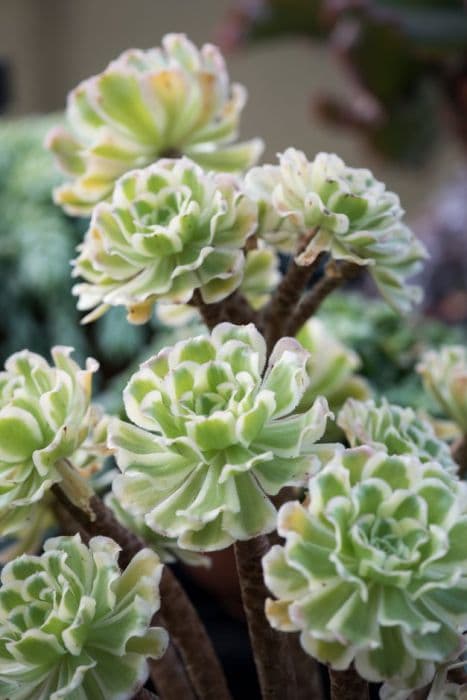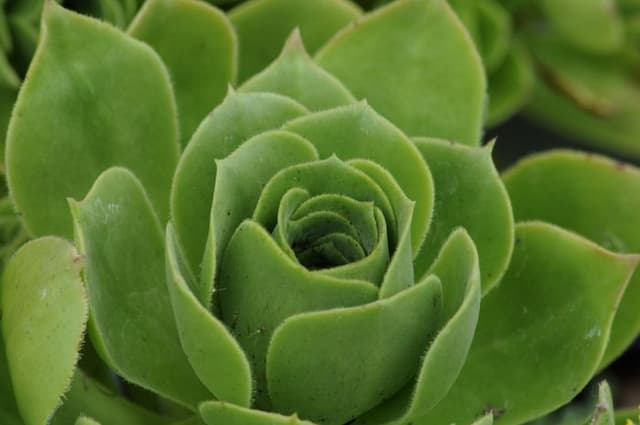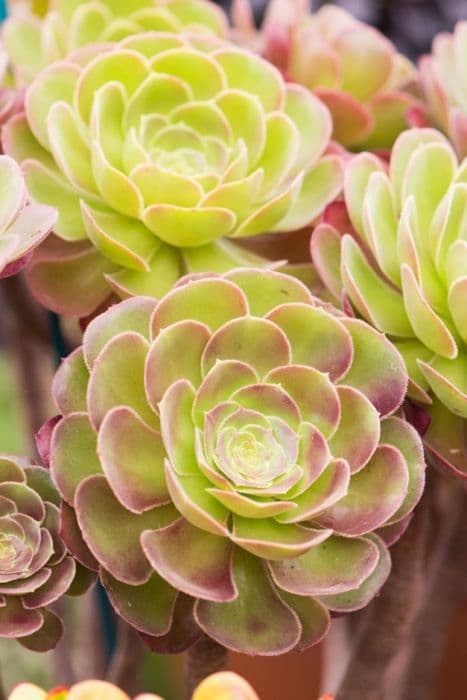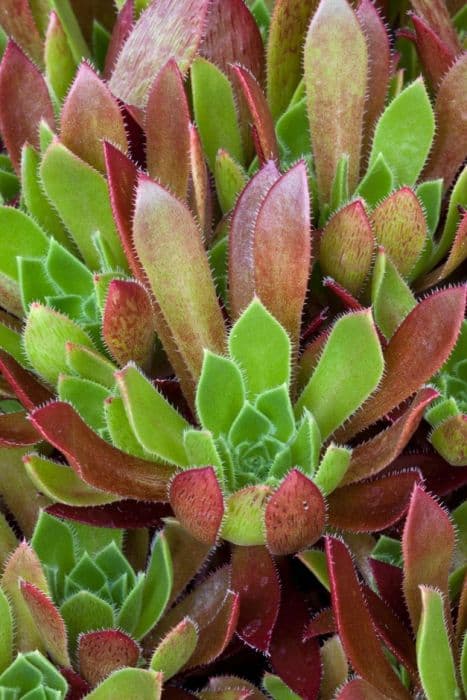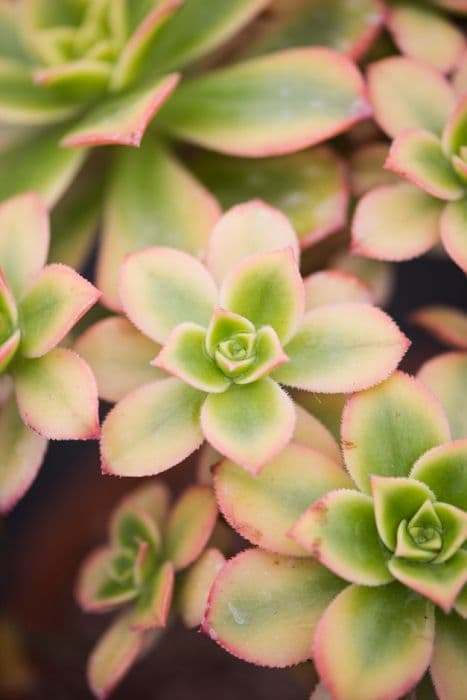Stonecrop Hylotelephium 'Marchants Best Red'

ABOUT
The plant known as 'Marchants Best Red' is an attractive, succulent perennial that boasts a striking visual presence. This plant presents fleshy, rounded leaves that are designed to retain water, a feature typical of succulent plants. The leaves exhibit a rich, deep red coloration, which provides a vibrant splash of color and can add a dramatic accent to gardens or arrangements. During its blooming period, 'Marchants Best Red' produces clusters of tiny, star-shaped flowers. These flowers can range in hue from soft pink to bold magenta, contrasting beautifully with the red foliage. The blossoms are tightly packed together, forming a showy, rounded flowerhead. This plant possesses sturdy, upright stems which hold the flowerheads aloft and allow them to be displayed prominently. The stems themselves may also take on reddish tones, complementing the color scheme of the foliage and flowers. Overall, 'Marchants Best Red' has a full, lush appearance with textures and colors that are visually striking throughout its growing season.
About this plant
 Names
NamesFamily
Crassulaceae.
Synonyms
Sedum, Stonecrop.
Common names
Hylotelephium telephium 'Marchants Best Red', Sedum telephium 'Marchants Best Red'.
 Toxicity
ToxicityTo humans
The plant commonly known as Stonecrop is not known to be highly toxic to humans. While the toxicity varies among species within the genus, most are considered to have low toxicity. If ingested in large quantities, it may cause mild gastrointestinal discomfort, but significant poisoning is rare. It is always advisable to avoid ingesting parts of ornamental plants due to the potential for adverse reactions.
To pets
The Stonecrop plant is generally considered to have low toxicity for pets as well. While it is unlikely to cause severe poisoning, ingestion of large amounts can lead to gastrointestinal upset in some animals, such as vomiting or diarrhea. It is recommended to prevent pets from consuming the plant to avoid these potential issues.
 Characteristics
CharacteristicsLife cycle
Perennials
Foliage type
Deciduous
Color of leaves
Red
Flower color
Red
Height
1-2 feet (30-60 cm)
Spread
1-2 feet (30-60 cm)
Plant type
Succulent
Hardiness zones
3-9
Native area
Asia
Benefits
 General Benefits
General Benefits- Attracts Pollinators: Hylotelephium 'Marchants Best Red', commonly known as Stonecrop, is known for attracting bees and butterflies, which are crucial for pollinating many different types of plants.
- Drought Tolerance: Stonecrop is highly drought-tolerant, making it an excellent choice for xeriscaping and reducing the need for regular watering once established.
- Easy to Grow: This plant is recognized for being low-maintenance and easy to cultivate, which is beneficial for gardeners of all skill levels.
- Seasonal Interest: Stonecrop provides visual interest throughout multiple seasons with its colorful foliage and flowers, enhancing the aesthetic appeal of gardens.
- Soil Adaptability: It can adapt to a range of soil types, although it prefers well-draining soil, making it a versatile addition to different garden environments.
- Pest Resistant: Generally, Stonecrop is resistant to pests, reducing the need for chemical treatments.
- Winter Hardy: With its ability to survive cold temperatures, it is a great choice for gardens in a variety of climates, especially in colder regions.
- Succulent Leaves: The succulent leaves can add texture and contrast to garden compositions, providing a unique aesthetic quality.
- Propagation Ease: Stonecrop can be easily propagated from cuttings or offsets, allowing gardeners to easily expand their plants or share with others.
- Edging and Groundcover: Its growth habit makes it useful for edging and groundcover purposes, creating a lush and cohesive garden look.
- Long Blooming Period: Stonecrop often has a long flowering period from summer to fall, providing long-lasting color in the garden.
 Medical Properties
Medical PropertiesThis plant is not used for medical purposes.
 Air-purifying Qualities
Air-purifying QualitiesThis plant is not specifically known for air purifying qualities.
 Other Uses
Other Uses- Photography and Art Subject: The vivid red leaves of the Autumn Joy can be an excellent subject for photographers and artists, especially in autumn when the foliage changes color.
- Educational Tool: The plant can be used in educational settings to demonstrate the life cycle of perennials or to study pollinator-plant relationships due to its attractive blooms.
- Psychological Well-being: Planting Autumn Joy in personal or communal gardens can contribute to mental health by offering a serene and aesthetically pleasing environment.
- Erosion Control: Autumn Joy can be used in erosion control efforts due to its extensive root system that helps to stabilize soil on slopes.
- Biomarkers: They can potentially be used in research as biomarkers to study environmental changes, as certain aspects of the plant's growth or color might respond to specific conditions.
- Seasonal Decorations: Dried Autumn Joy flowers and stems can be used to create beautiful seasonal wreaths or arrangements for fall decoration.
- Culinary Garnish: Although not commonly used for consumption, the flowers could potentially serve as a garnish for special dishes, provided they are clean and free from pesticides.
- Natural Dye: The plant material, particularly the leaves and stems, might be used to create a natural red dye for fabrics or crafts.
- Ice Preservation: Autumn Joy flower heads can be frozen into decorative ice blocks for display during winter festivals or in ice sculptures.
- Moss Prevention: The dense growth of Autumn Joy can help shade soil and prevent moss growth in certain garden settings where moss is undesired.
Interesting Facts
 Feng Shui
Feng ShuiThe plant 'Stonecrop' is not used in Feng Shui practice.
 Zodiac Sign Compitability
Zodiac Sign CompitabilityThe plant 'Stonecrop' is not used in astrology practice.
 Plant Symbolism
Plant Symbolism- Perseverance: As a hardy succulent, sedum symbolizes the ability to endure and thrive in challenging conditions, representing hardiness and the capacity to cope with life's struggles.
- Tranquility: Sedums are known for their serene and tranquil appearance, often symbolizing peace and calm in the garden or living space.
- Survival: The sedum's thick, moisture-retaining leaves represent the ability to store resources and survive in sparse environments, reflecting self-reliance and adaptability.
- Timelessness: As a perennial plant that returns year after year, sedums symbolize enduring presence and continuity over time.
- Healing: Historically, some sedum species have been used in traditional medicine, which lends them a symbolic association with healing and recovery.
 Water
WaterThe Stonecrop should be watered thoroughly, allowing the soil to dry out completely between waterings. Overwatering can be detrimental, so it’s crucial to check the soil moisture before adding more water. Typically, watering once a week during the growing season is sufficient, but this may vary depending on climate and weather conditions. During the winter, when the plant is dormant, reduce watering to once every two to three weeks. When you do water, provide enough so that water runs out of the drainage holes, which may be approximately one gallon for a large pot.
 Light
LightStonecrop thrives in full sunlight, where the plant can receive at least 6 hours of direct sun each day. The best spot for Stonecrop is in an area that is exposed to unfiltered, natural light. While it can tolerate partial shade, its growth and bloom might not be as vigorous.
 Temperature
TemperatureStonecrop is hardy and can tolerate a wide temperature range. It can survive minimum temperatures down to about 0°F and is comfortable during the growing season with temperatures up to 90°F. The ideal temperature range for Stonecrop is between 65°F and 75°F, which promotes healthy growth and flowering.
 Pruning
PruningStonecrop should be pruned to remove dead or damaged foliage and to encourage a compact growth habit. Pruning is best done in early spring before new growth begins. Pruning can also be done after flowering to remove spent blooms, which can help to stimulate a second bloom in some varieties.
 Cleaning
CleaningAs needed
 Soil
SoilThe best soil mix for Sedum 'Marchants Best Red' should be well-draining with a mix of loam, sand, and peat. The ideal pH should be slightly acidic to neutral, in the range of 6.0 to 7.0.
 Repotting
RepottingSedum 'Marchants Best Red' should be repotted every two to three years or when it outgrows its current pot, which can prevent overcrowding and promote healthy growth.
 Humidity & Misting
Humidity & MistingSedum 'Marchants Best Red' prefers low to average humidity levels and should thrive in typical household humidity conditions.
 Suitable locations
Suitable locationsIndoor
Place Sedum 'Marchants Best Red' in a well-lit spot, ensure good airflow.
Outdoor
Plant in a sunny spot with well-draining soil and space to grow.
Hardiness zone
3-9 USDA
 Life cycle
Life cycleThe life cycle of Hylotelephium 'Marchant's Best Red', commonly known as Stonecrop, begins with seed germination which occurs in warm, moist soil conditions usually in late spring or early summer. The seedlings will establish themselves quickly, developing roots and a rosette of leaves. As the plant matures, it enters a vegetative stage where it grows and expands, with thick, succulent leaves storing water and its stems becoming sturdier. During late summer or early autumn, Stonecrop will produce clusters of small, star-shaped red flowers that are attractive to bees and butterflies. After flowering, the plant sets seed which can be dispersed by wind or wildlife, and as the temperatures drop in late autumn, the above-ground parts of the plant may die back, though the roots remain alive. In the winter, the plant rests and conserves energy, with new growth resuming in the following spring to start the cycle again.
 Propogation
PropogationPropogation time
Spring-Early Summer
Hylotelephium 'Marchants Best Red', commonly known as stonecrop, is most effectively propagated by stem cuttings. The ideal time to take stem cuttings is in late spring or early summer when the plant is actively growing. To propagate, select a healthy stem and cut a 2 to 4-inch (5 to 10 cm) length, making sure the cutting includes at least one or two leaf sets. The lower leaves are then stripped off, and the cut end is allowed to callous over for a few days. Once calloused, the cutting can be placed in well-draining soil, ensuring that the soil is kept moderately moist but not waterlogged. Roots typically begin to form within a few weeks, and the new plant will establish itself gradually, ready to be transplanted if necessary.
